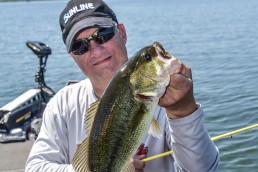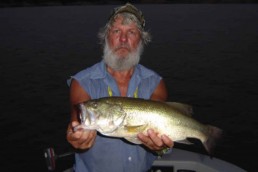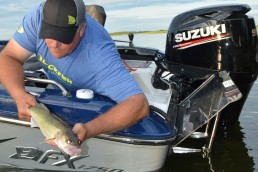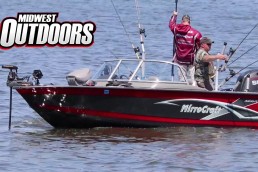Weather and How it Affects Your Fishing
SHARE THIS POST
Have you ever wondered how much effect the weather has on your fishing? It may have more influence than you give it credit for. Let’s take a closer look at different weather conditions and how you should adjust to put more fish over the side of your boat.
We hear terms like cold front, high pressure, and low pressure, to just name a few. What do these weather terms mean? How will they change the fishing in my lake? More importantly, how should I adjust to put the odds in my favor?
It all starts with staying informed. You can get weather information from TV, radio, and the phones that we all carry around to stay in contact with work or family. If you have not already downloaded a weather app to your phone, you need to. It keeps you up to date on what the weather has in store for you and your next fishing trip.
I myself like to start tracking the weather around Wednesday if I am fishing on the weekend. That way I get the big picture of what has happened to the weather leading up to fishing. That tells me what will be happening during my time out on the water. In other words, what have the fish been doing and where will they be at when I hit the water? This gives me a whole picture to look at, instead of just what is happening when I get out on the water.
Presentations: vertical and horizontal
In fishing, we do two different types of presentation methods: vertical, and horizontal. A vertical presentation you cast out and work back to the boat along the bottom—examples are jigs, Texas rig worms or craws, and a Carolina rig. A horizontal presentation you cast out and reel back or troll behind the boat. Examples of a horizontal presentation are crankbaits, topwaters, spinnerbaits, and rattle-type baits, to name a few.
Weather terms:
Cold front conditions
Let’s start out with the cold front, the front that you could say has the most effect on your fishing. If the forecast calls for a cold front to move into your area, this means that there will not be any clouds in the sky. It’s a bright, sunny day. The perfect day to get out of the rain suit you have been wearing for the past two days. You are thinking, “great, I can fish with a pair of shorts and a T-shirt tomorrow and the predicted high is 80, I can feel it now the bite will be on.”
In fishing reality, this is one of the toughest days to be on the water. With the lack of clouds, and the bright sky, the fish will do one of two things. One, they may move towards deeper water to get away from the sun. Two, they will bury up in cover. The biggest factor here is their strike zone will get smaller. Now, many will agree with me it is not the sun that fish are trying to escape from, it is the high-pressure conditions.
Are you enjoying this post?
You can be among the first to get the latest info on where to go, what to use and how to use it!
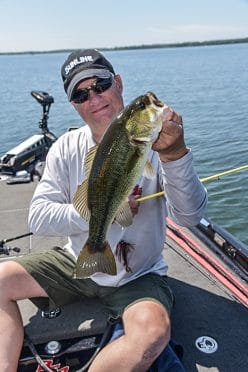
How to fish cold front conditions
Slow down, downsize your baits, and use live bait if that is an option. In all reality, the days that you thought are the best days to be on the water really are. But, as a fisherman, your low catch will pay the price. These are the days that you have to cast to targets and get your bait into the cover, not just pull a bait over the top of the rocks or weeds. Chances are, that may not trigger bites. Remember the fish will bury up in the cover. Fishing a jig for bass outside of the weeds will not work. You will have to go into the weeds after them to trigger a strike. Remember, the fish’s strike zone will be small. You will have to almost hit them with your bait to trigger strikes. Cold fronts will have an effect on the fish for about 1 to 1 1/2 days. After that, fish will get back on the feed again and the strike zone will start to expand.
Warm front conditions
Warm fronts mean that a change is on the horizon, clouds will start to move into the area. The pressure will start to drop. This will send the message to the fish to put on the feed bag. High pressure will follow. They will slow down and may not feed for a day or so, meaning now is the time to start to eat. Strike zones will start to get larger and the fish will chase down food.
How to fish warm fronts
In these conditions, you can fish around areas to draw fish out to strike. Crankbaits, spinnerbaits and lindy rigs are just a few of the baits to use during these conditions. Fish will be active and somewhat on the bite. They know change is about to happen. If you are not getting bites, it is time to move on as the strike zone for these fish will be increasing.
Clouds and rain
These are the days that fishing is made of. This is where the phrase “you should have been here yesterday” came from. Weather reports say that the storm is going to hit this afternoon and you can see the rain and the storm getting ready to move in. Do not get me wrong, these days are at times nothing to mess with. You need to pay attention to your phones and take action if action is needed to get off of the water. Some of these days will add up to making some of the best days that you will experience on the water. Like I said earlier, these are the days where the phrase “you should have been here yesterday” comes from. Enjoy these days on the water, but do not put yourself at risk. Fish safe.
How to fish cloudy, stormy conditions
Fish baits that you can cover water with. You will not have to convince these fish to bite, you will just have to get the bait in front of them. To put the most odds in your favor, use bait that make noise—rattle traps, crankbaits with rattles, topwater and spinnerbaits are just a few examples. During these days on the water, stay on the move and cover water.
So, as you can see, weather does have an impact on your fishing. But, how you respond to these weather changes will be what puts the most odds in your favor. Pay attention to the weather before you hit the water. During your time on the water, make adjustments as you go to match the conditions you are faced with.
MWO
SHARE THIS POST
Did you enjoy this post?
You can be among the first to get the latest info on where to go, what to use and how to use it!
Scott Petersen
Scott Petersen has been writing for the past 30 years. A Minnesota native, he has a passion to fish all seasons on ice and open water. “One of my main goals is to teach people how to fish through my articles and sport-show seminars.”
